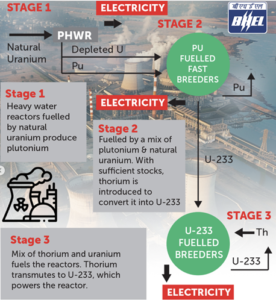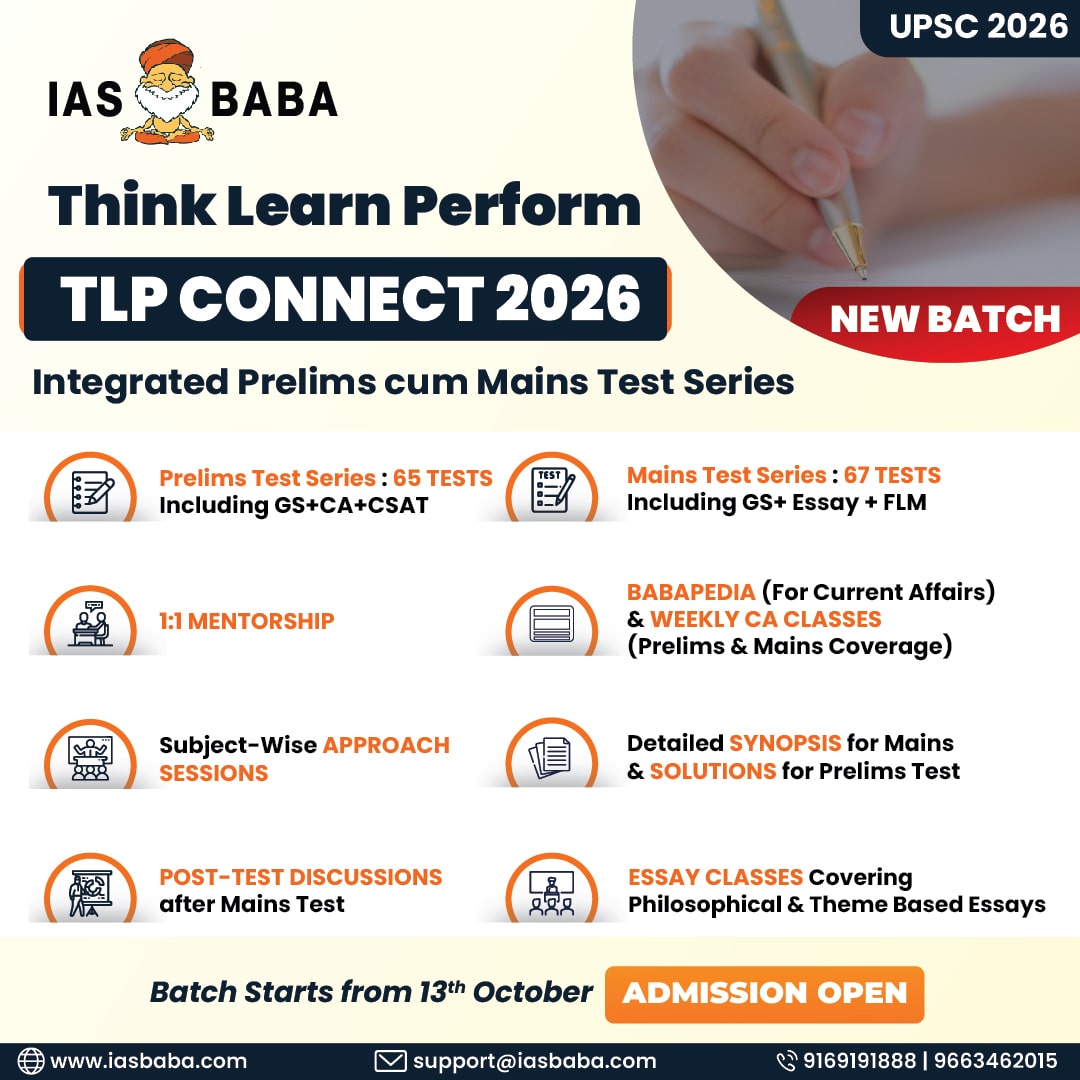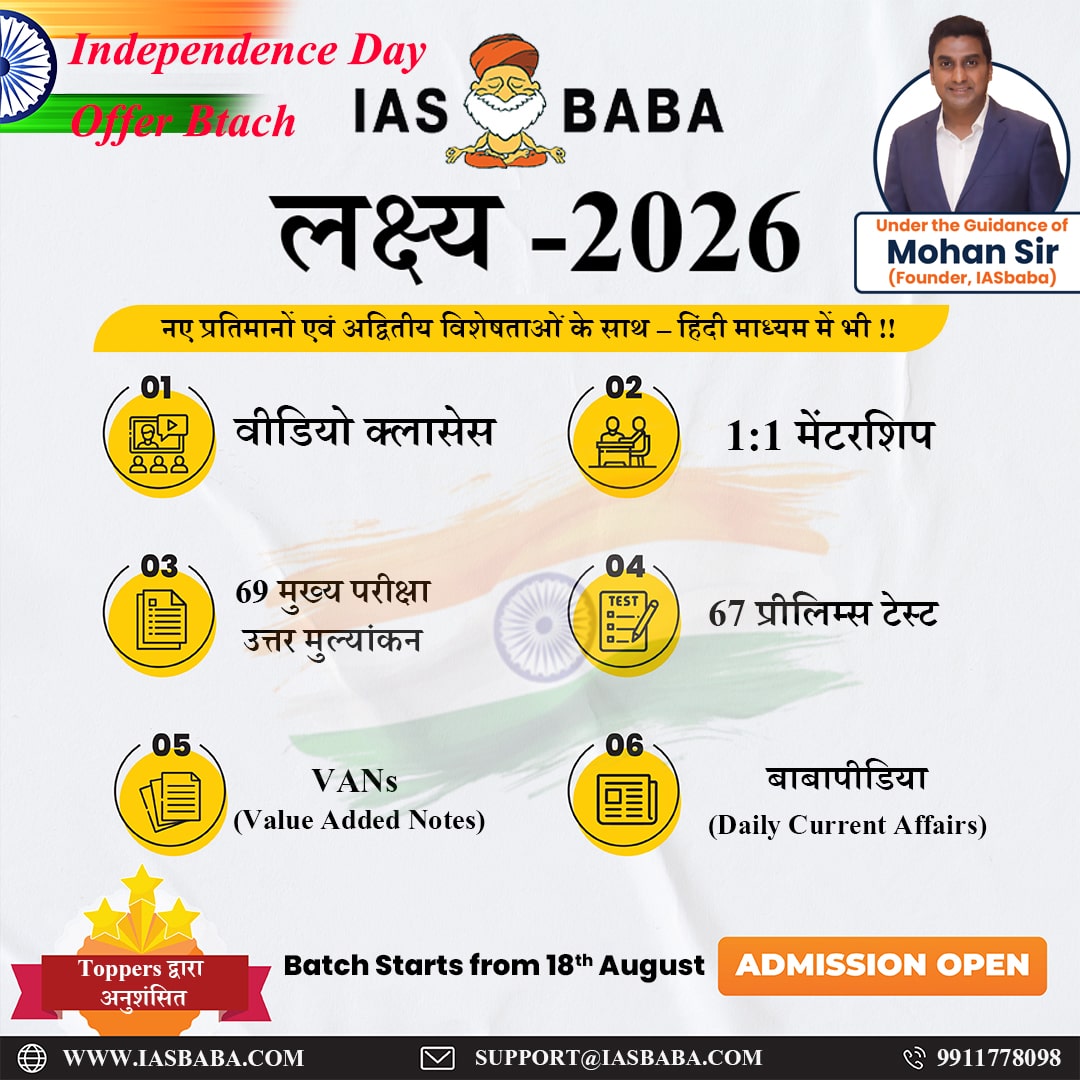IASbaba's Daily Current Affairs Analysis
Archives
(PRELIMS & MAINS Focus)
Syllabus:
SCIENCE & TECHNOLOGY
Context: Russian President Vladimir Putin launched Perm, a nuclear-powered submarine with hypersonic Zircon missiles. Perm is the first of its kind to be equipped with Zircon (also spelled Tsirkon) missiles as a standard feature.
Decoding the context: According to the Russian news agency TASS, Putin described its launch as a “milestone event” for the Russian navy.
Learning Corner:
- Hypersonic missiles are advanced weapons that travel at speeds of Mach 5 (five times the speed of sound) or higher (≥ 6,174 km/h). They are designed for high-speed, maneuverability, and rapid strike capability.
Advantages of Hypersonic missiles
- The main feature of a hypersonic missile is its maneuvrability, meaning its trajectory can be altered according to the intended target. These are generally slower than intercontinental ballistic missiles.
- Hypersonic weapons can potentially evade missile shields and early warning systems. Ground-based radars or terrestrial radars cannot detect hypersonic missiles until late in the flight of the weapon. This makes it difficult for the responders to the missile attack to try to intercept the missile.
- Hypersonic weapons can enable responsive, long-range strike options against distant, defended or time-critical threats (such as road-mobile missiles) when other forces are unavailable, denied access or not preferred.
- Conventional hypersonic weapons use only kinetic energy, energy derived from motion, to destroy unhardened targets or even underground facilities.
- The two types of hypersonic weapons systems are Hypersonic Glide Vehicles (HGVs) and Hypersonic Cruise Missiles (HCMs).
- HGVs are launched from a rocket before gliding to the intended target, while HCMs are powered by air-breathing high-speed engines or ‘scramjets’ after acquiring their target.
What to know about ZIRCON
- According to Russia, the Zircon can reach eight times the speed of sound, has a range of 625 miles and can carry a 660-pound warhead.
- If this is accurate, Zircon would be one of the fastest in the world, “making it nearly impossible to defend against due to its speed alone.”
Source : Indian Express
Syllabus:
SCIENCE & TECHNOLOGY
Context: A fiery exchange erupted in Rajya Sabha when Congress MP Jairam Ramesh questioned the progress of phase 2 of the nuclear programme of India, the status of the fast breeder reactor in Kalpakkam, and the plans for setting up thorium reactors for Phase 3.
Decoding the context: India’s nuclear journey began shortly after Independence with the establishment of the Atomic Energy Commission in 1948. In 1956, Asia’s first research reactor, Apsara, was commissioned at the Bhabha Atomic Research Centre (BARC) in Trombay. India was the second Asian nation to build a nuclear power plant in 1969 at Tarapur, just after Japan and long before China.
Learning Corner:

- India owes the vision of the three-phase programme of nuclear power to ensure energy security to Dr Homi J Bhabha, the father of India’s nuclear programme, and Dr Vikram Sarabhai, who recognised the need for developing Fast Breeder Reactor (FBR).
Three-stage nuclear programme
Stage I: Pressurised Heavy Water Reactors (PHWRs)
- Fuel and Operating Principle: In the first stage, India relies on Pressurised Heavy Water Reactors that use natural uranium as fuel.
- Key Characteristics: These reactors utilize heavy water (deuterium oxide) as both a moderator and coolant, allowing them to efficiently sustain the nuclear chain reaction with low-enriched fuel.
- Outcome: A byproduct of this stage is the production of plutonium-239 in the spent fuel, which is essential for the next phase of the programme.
Stage II: Fast Breeder Reactors (FBRs)
- Role of Plutonium: Stage II capitalizes on the plutonium produced in Stage I. Fast Breeder Reactors use a mix of plutonium and natural uranium in a process known as “breeding.”
- Breeding Process: These reactors are designed to generate more fissile material than they consume. Fast neutrons (without slowing by a moderator) convert the fertile uranium-238 into additional plutonium, thereby increasing the fissile inventory.
- Objective: The goal is to build up a significant stock of fissile material that will bridge the gap between the limited uranium resources and the future utilization of thorium.
- Implementation Status: The Prototype Fast Breeder Reactor (PFBR) at Kalpakkam is a critical milestone in this stage, although its progress has faced delays.
Stage III: Thorium-Based Reactors
- Rationale for Thorium: India possesses one of the world’s largest reserves of thorium (approximately 25% of the global share), but only limited uranium resources. Thorium-232, which is not fissile in its natural state, needs to be converted (or “bred”) into uranium-233 through neutron irradiation.
- Reactor Development: The final stage envisions advanced thermal breeder reactors—such as Advanced Heavy Water Reactors (AHWRs) and other concepts like molten salt reactors—that utilize a thorium–uranium-233 fuel cycle.
- Long-Term Vision: Once the necessary fissile material has been accumulated in Stage II and the technology for breeding uranium-233 from thorium is perfected, India aims to achieve sustained nuclear power generation that relies primarily on its abundant thorium resources.
- Impact: This stage is expected to drastically reduce dependence on imported uranium and pave the way for a self-reliant nuclear energy programme lasting for centuries.
Source : Indian Express
Syllabus:
INTERNATIONAL
Context: External Affairs Minister (EAM) S. Jaishankar emphasized that BIMSTEC should adopt a more ambitious approach amid the ongoing global churn that is creating a new world order which is more regional and agenda-specific.
Decoding the context: Addressing a meeting of foreign ministers of the BIMSTEC in Bangkok, Jaishankar emphasised the central role of India, especially its landlocked northeastern region, in forging transport and connectivity linkages. The meeting was part of the preparations for the Bimstec Summit, and was held hours after US President unveiled his reciprocal tariffs.
Learning Corner:
- BIMSTEC is a regional organization comprising countries around the Bay of Bengal that aims to foster economic and technical cooperation. The organization bridges South Asia and Southeast Asia.
- BIMSTEC comprises seven member states:
- South Asia: Bangladesh, Bhutan, India, Nepal, Sri Lanka
- Southeast Asia: Myanmar, Thailand
- It was established on June 6, 1997, through the Bangkok Declaration.
- Initially known as BIST-EC (Bangladesh, India, Sri Lanka, Thailand Economic Cooperation), it was later renamed BIMSTEC after the inclusion of Myanmar in 1997.
- The permanent secretariat is located in Dhaka, Bangladesh.
- Rotational Chairmanship: Leadership is rotated among members by a pre-determined order, ensuring that each country plays a central role in driving the agenda. Decisions are made on a consensus basis.
- BIMSTEC Charter was adopted during the 5th BIMSTEC Summit (2022), giving the organization a legal framework.
Objectives
- Promote economic growth and social progress in the region.
- Encourage trade and investment cooperation.
- Foster transport and connectivity.
- Strengthen regional security.
- Enhance technical and scientific collaboration.
- Work towards sustainable development.
Source : Hindustan Times
Syllabus:
GEOGRAPHY
Context: Ahead of Prime Minister Narendra Modi’s visit to Sri Lanka, the Tamil Nadu Legislative Assembly unanimously adopted a resolution, urging the Union government to take steps to retrieve the Katchatheevu island from Sri Lanka.
Decoding the context: The resolution moved by Chief Minister M.K. Stalin said: “Retrieval of Katchatheevu island is the only permanent solution to protect the traditional fishing rights of Tamil Nadu fishermen and to mitigate the sufferings faced by them due to the Sri Lankan Navy.”
Learning Corner:
- Katchatheevu is a small, uninhabited island in the Palk Strait, between India and Sri Lanka.
- Katchatheevu covers an area of around 285 acres (approximately 115 hectares) and is situated roughly 33 kilometers from Rameswaram and 62 kilometers from Jaffna.
History
- Originally controlled by the Raja of Ramanathapuram (Tamil Nadu) during British rule.
- The British administration did not clearly define its sovereignty.
- After India’s independence (1947) and Sri Lanka’s independence (1948), both nations claimed the island.
- 1968 Agreement Between India and Sri Lanka
- The Indo-Sri Lankan Maritime Agreement (1974) officially transferred Katchatheevu to Sri Lanka.
- The agreement was signed between Indian Prime Minister Indira Gandhi and Sri Lankan Prime Minister Sirimavo Bandaranaike.
- The treaty stated that Indian fishermen could continue to use the island for resting, drying their nets, and visiting the St. Antony’s Church for religious purposes.
Fishermen Disputes
- Indian fishermen, especially from Tamil Nadu, frequently enter waters around Katchatheevu for fishing.
- The Sri Lankan Navy arrests and detains Indian fishermen who are accused of illegal fishing in Sri Lankan waters.
- Tamil Nadu fishermen claim traditional fishing rights over the area.
- The Sri Lankan government restricts Indian fishing activities, citing depletion of fish resources and violations of their maritime boundary.
Religious Significance
- The St. Antony’s Church, located on Katchatheevu, is an important place of worship.
- It hosts an annual Catholic festival, attended by both Indian and Sri Lankan pilgrims. The event is an example of cultural and religious ties between the two nations.
Source : The Hindu
Syllabus:
SCIENCE & TECHNOLOGY
Context: The Uttar Pradesh Jal Nigam, the state’s water authority, has identified a significant problem of excessive fluoride in the groundwater of 120 hamlets, impacting nearly 2 lakh people.
Decoding the context: Sonbhadra, UP’s second-largest district, has been struggling with fluoride contamination. Rich deposits of granite, an igneous rock, have leached “excess” fluoride into the groundwater, making it unfit for human consumption.
Learning Corner:
- Fluoride contamination refers to the presence of fluoride in water at concentrations higher than the levels considered safe for human consumption.
- While fluoride in small amounts can be beneficial for dental health—helping to prevent tooth decay—excessive fluoride intake can lead to serious health issues.
- Fluoride Contamination is a serious issue in Rajasthan, Gujarat, Andhra Pradesh, Telangana, Karnataka, Madhya Pradesh, and Uttar Pradesh.
- Fluoride contamination primarily occurs in groundwater due to:
- Natural sources
- Weathering of fluoride-rich rocks (e.g., granites, basalts).
- Volcanic activity releases fluoride into the environment.
- Industrial pollution
- Fluoride is released from industries like aluminum, steel, glass, and fertilizer production.
- Agricultural practices
- Excessive use of phosphate fertilizers and pesticides leads to fluoride leaching into water.
- Coal combustion
- Burning coal releases fluoride into air and water sources.
- Natural sources
- The World Health Organization (WHO) recommends a safe fluoride level of 0.5 – 1.5 mg/L in drinking water. More than 1.5 mg/L can lead to fluorosis (bone and teeth damage).
Health Impacts of Excess Fluoride
- Dental Fluorosis: When children consume water with high fluoride levels, it can result in dental fluorosis. This condition causes changes in the appearance and structure of tooth enamel, ranging from mild discoloration to severe enamel pitting.
- Skeletal Fluorosis: Prolonged ingestion of high fluoride levels can lead to skeletal fluorosis—a crippling disease characterized by pain and damage to bones and joints. Over time, the accumulation of fluoride in bones can increase the risk of fractures and cause stiffness and calcification of ligaments.
Prevention and Control Measures – Water Treatment Methods
- Activated Alumina Filters – Absorbs fluoride from water.
- Reverse Osmosis (RO) Filtration – Highly effective in fluoride removal.
- Nalgonda Technique – Uses alum, lime, and bleaching powder to remove fluoride from water (low-cost method).
Source : Indian Express
Practice MCQs
Q1. Which of the following countries is NOT a member of BIMSTEC?
- a) Nepal
b) Maldives
c) Myanmar
d) Bhutan
Solution (b)
Q2. Which religious site is located on Katchatheevu Island?
- a) Velankanni Church
b) St. Antony’s Church
c) Meenakshi Temple
d) Rameswaram Temple
Solution (b)
Q3. Consider the following statements regarding Fluoride Contamination:
- Fluoride contamination in water can occur through both natural geological processes and and excessive use of phosphate fertilizers.
- Prolonged exposure to high levels of fluoride can cause both dental and skeletal fluorosis.
- The Nalgonda Technique, commonly used for fluoride removal, is a high-cost water purification method that involves the use of activated carbon and ultraviolet filtration.
Which of the statements given above is/are correct?
- a) 1 and 2 only
b) 2 and 3 only
c) 1 and 3 only
d) 1, 2, and 3
Solution (a)
Comment the answers to the above questions in the comment section below!!
ANSWERS FOR ’ Today’s – Daily Practice MCQs’ will be updated along with tomorrow’s Daily Current Affairs
ANSWERS FOR 2nd April – Daily Practice MCQs
Q.1) – b
Q.2) – b
Q.3) – b













